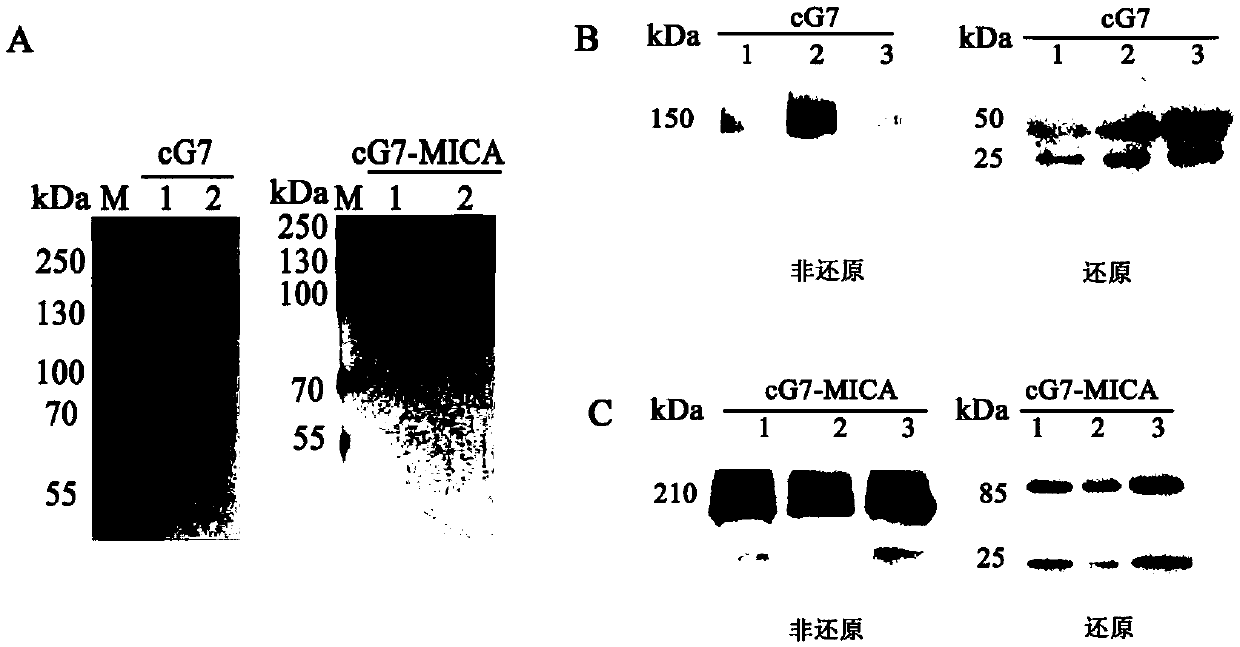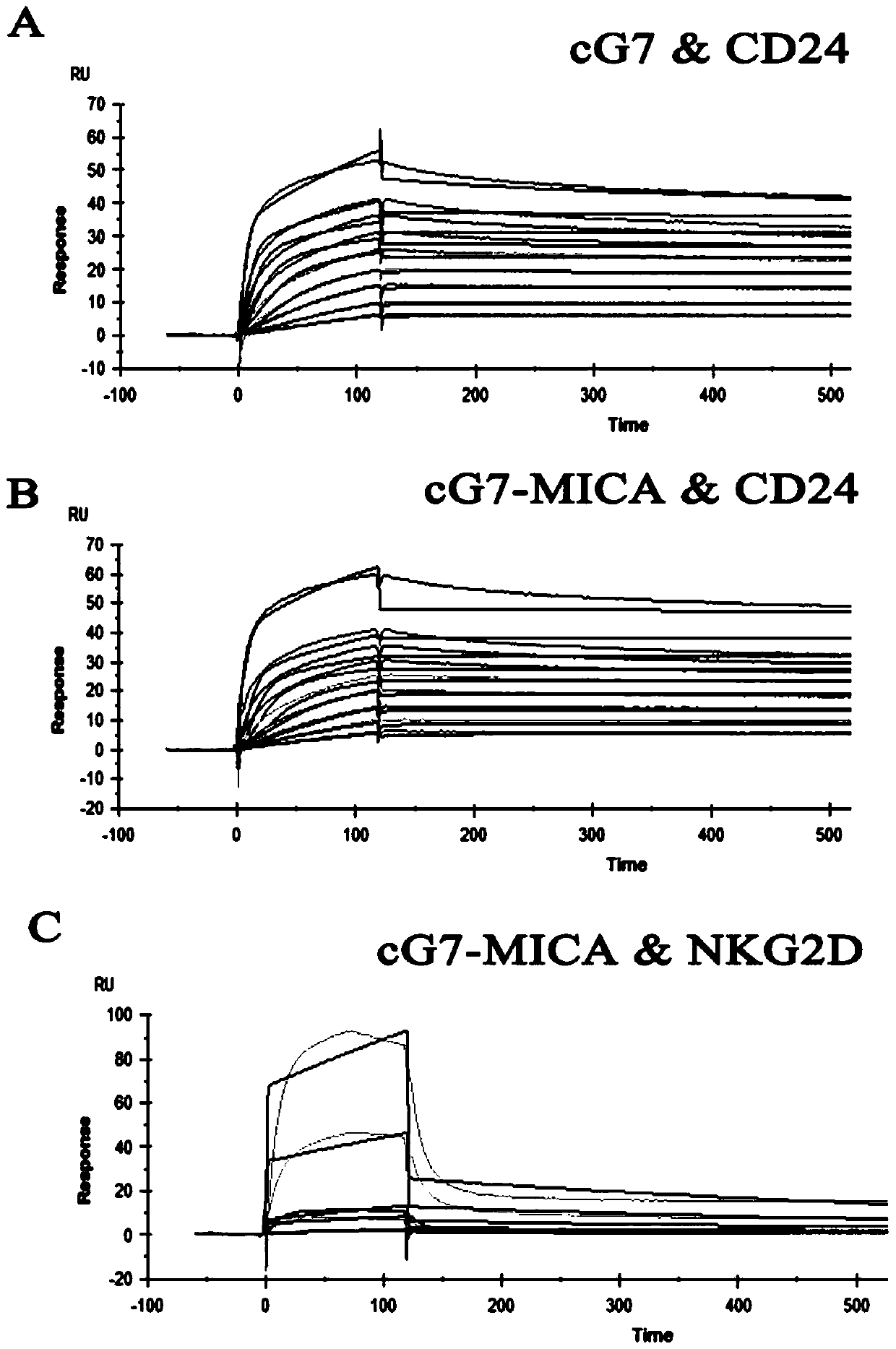Preparation method and application of bispecific antibody targeting CD24 (cluster of differentiation 24) and activating NK cells (natural killer cells)
A bispecific antibody, CD24 technology, applied in the direction of antibodies, applications, specific peptides, etc., can solve problems such as shedding, and achieve the effect of inhibiting growth
- Summary
- Abstract
- Description
- Claims
- Application Information
AI Technical Summary
Problems solved by technology
Method used
Image
Examples
Embodiment 1
[0033] Example 1 Construction of bispecific antibody cG7-MICA targeting CD24.
[0034] First, use the rG7s-MICA independently developed by the laboratory as a template to design primers to transfer the heavy and light chain variable region genes, and use the lab-protected IgG1 constant region gene as a template to design primers to transfer the heavy and light chain constant region genes. The variable region and the constant region of the light chain were respectively connected by overlapping PCR technology to construct the heavy chain (H-chain) and light chain (L-chain) genes of cG7. At the same time, continue to use rG7s-MICA as a template to design primers to transfer the gene of extracellular region 1-3 of human MICA, and design primers to transfer the heavy chain gene of cG7, and use the overlap PCR technology to pass the flexible peptide (Gly 4 Ser) connects these two genes to form the heavy chain (H'-chain) of cG7-MICA, and cG7-MICA is consistent with the light chain of...
Embodiment 2
[0035] Example 2 Expression, purification and identification of bispecific antibody cG7-MICA targeting CD24.
[0036]First, the four recombinant plasmids H'-pMH3, H'-pCApuro, L-pMH3 and L-pCApuro were introduced into CHO-s cells by electric shock method (in a 0.4cm electric shock cup, 160V, 15ms) in equal proportions, and two After rounds of pressurized screening (Dot Blot semi-quantitative screening), cell lines with stable and high expression of cG7-MICA were obtained. The screened high-expression cell lines were expanded step by step, the cell culture fluid was collected, and the sample was filtered through a 0.22 μm filter membrane, followed by protein A affinity chromatography purification, and finally a large amount of the target antibody was obtained. 10% SDS-PAGE protein electrophoresis to identify the molecular weight and purity, and Western blot to initially verify the target protein to see if it is assembled correctly.
Embodiment 3
[0037] Example 3 SPR experiment of bispecific antibody cG7-MICA targeting CD24.
[0038] In this experiment, the interaction of cG7-MICA with the antigen CD24 and the MICA receptor NKG2D was measured using BiacoreX100 as an SPR-dependent biosensor. Use the Human Antibody capture kit to couple 25 μg / mL anti-human IgG (Fc) antibody to the surface of the activated CM5 chip (coupling is limited to channel 2). Adjust the concentration of cG7 and cG7-MICA to 10 μg / mL, and use the anti-human IgG (Fc) antibody on the CM5 chip to specifically capture cG7 and cG7-MICA. Afterwards, the naked CD24 peptide was diluted (from 100 nM to 0.39 nM) in a buffer ratio. At 25°C and a flow rate of 30 μL / min, samples were injected to detect the binding / dissociation ability between cG7 and cG7-MICA and CD24. Meanwhile, channel 1 acts as a reference channel without coupling or capturing any protein. Therefore, the signal detected by channel 1 will be used as reference data. After the natural dissoc...
PUM
 Login to View More
Login to View More Abstract
Description
Claims
Application Information
 Login to View More
Login to View More - R&D
- Intellectual Property
- Life Sciences
- Materials
- Tech Scout
- Unparalleled Data Quality
- Higher Quality Content
- 60% Fewer Hallucinations
Browse by: Latest US Patents, China's latest patents, Technical Efficacy Thesaurus, Application Domain, Technology Topic, Popular Technical Reports.
© 2025 PatSnap. All rights reserved.Legal|Privacy policy|Modern Slavery Act Transparency Statement|Sitemap|About US| Contact US: help@patsnap.com



